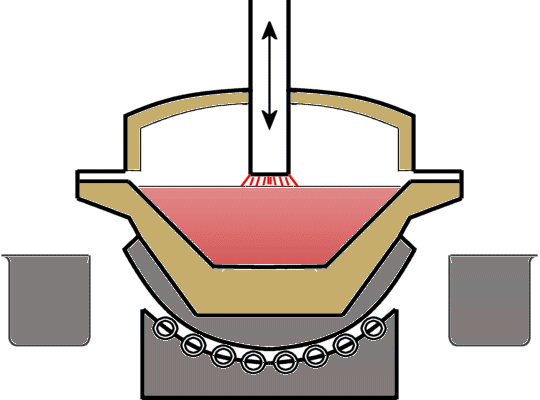
|
Steel production

Assignment
For some time now steel has been produced in Germany only in electrically fired kilns. Previously there was also the oxygen supported steel making process, and even earlier still ... The buyers of steel, for example
the motor industry, have exact stipulations for their respective supplies. The alloy constituents which are exactly weighed are part of these stipulations.
Function
In Europe, scrap metal is almost exclusively used for the production of steel. The kilns which are used, have a capacity of more than 100 tons. Carbon electrodes generate a high current heating arc which brings the
metal to melting point, during this process all foreign matters, for example phosphorus and sulphur are removed. In this process control samples are repeatedly extracted, until the quality of the kiln-load conforms
exactly to the requirements. Before the actual cast takes place, the alloy component-metals are introduced and the dross is skimmed off the top.
| Alloying increases the tensile strength. |
The casting takes place in continuous-cast equipment in which several bars, each weighing a few tons and about 6-meters in length, are poured simultaneously at a relatively low feed rate. It is important in this
operation, to keep the bars separated from the bars of the previous cast. After cooling off and marking, the bars can now be delivered or slowly reheated until they are glowing red hot and then continue to the rolling
mill where they are processed perhaps directly for a specific use, e.g., into plating or extruded into wire. Alternatively, the bars can be transported back and forth through the reversible tapering rollers causing the bars
to become thinner and longer with each run-through. During this process it is important that the bars undergo a rotation of 90° after each run-through to achieve the same compression and hardness on both sides.
The final product is transportable, relatively thin steel bars, sorted according to their attributes.
| Structural steel is sorted according to it's tensile strength. |
The above picture shows an electric kiln where the lid can be tilted for filling with scrap metal. The lid also houses the carbon electrodes which are driven toward or away from each other to produce the heating arc.
The steel construction of the kiln is protected against the melt by fire-resistant bricking. The melting process may be supported by the addition of oxygen. Finally, using a tipper mechanism the dross can be poured off
to one side and the steel to the other. 06/08
|
|